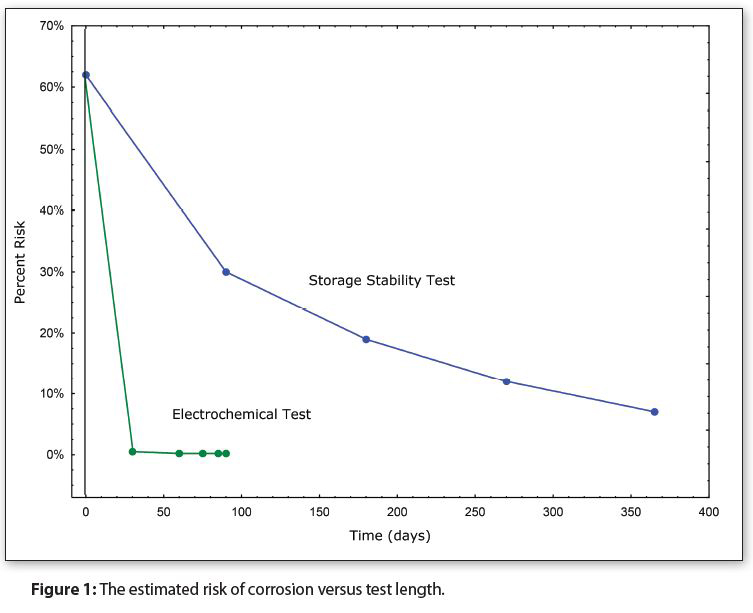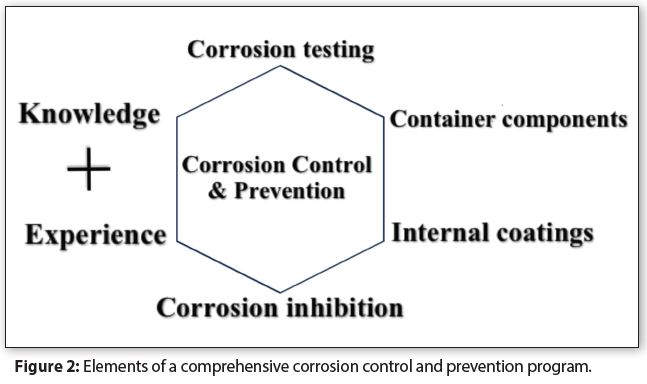Written on: September 1, 2023 by W. Stephen Tait
Hello, everyone. The risk of corrosion is always greater than zero and could be as high as 62%, particularly when there is no corrosion data for new formulas or derivatives of current formulas (line extensions).
Two types of corrosion tests are available for spray packaging: the traditional long-term storage stability test and the electrochemical corrosion test. Figure 1 depicts the risk associated with each of these corrosion tests as a function of test length.

The storage test curve in Figure 1 is from one-year-old package examinations for pitting corrosion, from approximately 7,500 aluminum, tin-plated steel and tin-free steel aerosol containers (approximately 750 to 1,000+ storage tests). The electrochemical curve in Figure 1 was generated from approximately 1,500 direct comparisons between predictions from test results and actual package corrosion.
Notice in Figure 1 that storage test risk decreases as the test length increases. In other words, results from a short storage test typically have a higher risk than results from a long storage test. Hence, this is why I recommend conducting storage tests for at least one year before making a go/no-go decision to commercialize a new product or a derivative product (line extension).
Figure 1 also illustrates that the risk for a properly-designed:
• Storage test—typically decreases from 62% to around 7% after one year of testing
• Electrochemical test—typically decreases from 62% to < 1% within 90 days of testing
Therefore, an electrochemical test can be completed in a significantly shorter time than a storage test with a corresponding lower risk.
Corrosion risk is always a concern
Changes to a formula’s chemical composition can cause very large changes in corrosion behavior. For example, a new fragrance or a new surfactant in a non-corrosive base formula sometimes results in a new, corrosive derivative product.
Corrosion can unexpectedly appear with changes in the concentrations of formula ingredients either by design or from manufacturing batch-to-batch variations. For example, an inhibitor can lose its effectiveness when its concentration is either above or below the effective concentration range. This means an inhibitor could actually cause corrosion when its concentration is outside of its effective range.
Substituting formula ingredients from alternate suppliers could also cause unexpected corrosion in spray packaging. Additionally, contamination, such as water in anhydrous formulas, is a common cause for spray package corrosion.
Variability in formula ingredients, formula ingredient concentrations, package components and materials of construction also causes random corrosion in some instances.
Comprehensive corrosion control & prevention
A corrosion control and prevention program has multiple components, as illustrated in Figure 2.
Corrosion testing is the linchpin of a comprehensive corrosion control and prevention program. Testing is used to determine formula compatibility with package components, metals and coatings.

A corrosive formula doesn’t necessarily have to be abandoned. In most instances, a corrosion inhibitor can be developed to transform a corrosive formula to a non-corrosive formula.
Also, maintained corporate knowledge, as well as an experience database, can be used to help avoid formula/package combinations and formula ingredients that have a high probability of causing spray package corrosion. Such a database can also reduce the number and length of corrosion tests in some situations.
“Knowledge” and “Experience” are shown in Figure 2 with a plus sign between them to emphasize their dependence on each other. Knowledge without practical experience, and experience without theoretical frameworks, are incomplete and will not result in useful, predictive professional practice; experience and knowledge work together to complete a comprehensive corrosion control and prevention program.
Understandably, corrosion control and prevention are typically not part of most corporate business plans and mission statements. However, product efficacy, quality and safety are!
Ignoring corrosion risk does not make it disappear; disregarding risk could lead to a major disruption of a business plan. Corresponding to that may be loss of income, re-deployment of resources to determine the cause and find a solution, as well as the delay of other projects. Ignoring risk can also result in either an expensive product recall or litigation—with subsequent potential loss of future sales when customers/consumers lose confidence in your products.
In most instances, corrosion testing is significantly cheaper than an in-market corrosion failure, as discussed in last month’s Corrosion Corner. A comprehensive corrosion control and prevention program also helps prevent the loss of productivity and expense that accompany an in-market product failure (leaking packages).
Consequently, corrosion prevention and control should be a continuous process and not a one-time event.
Thanks for your interest and I’ll see you in October. Contact me at 608-831-2076; rustdr@pairodocspro.com or from our two websites: pairodocspro.com and aristartec.com. SPRAY